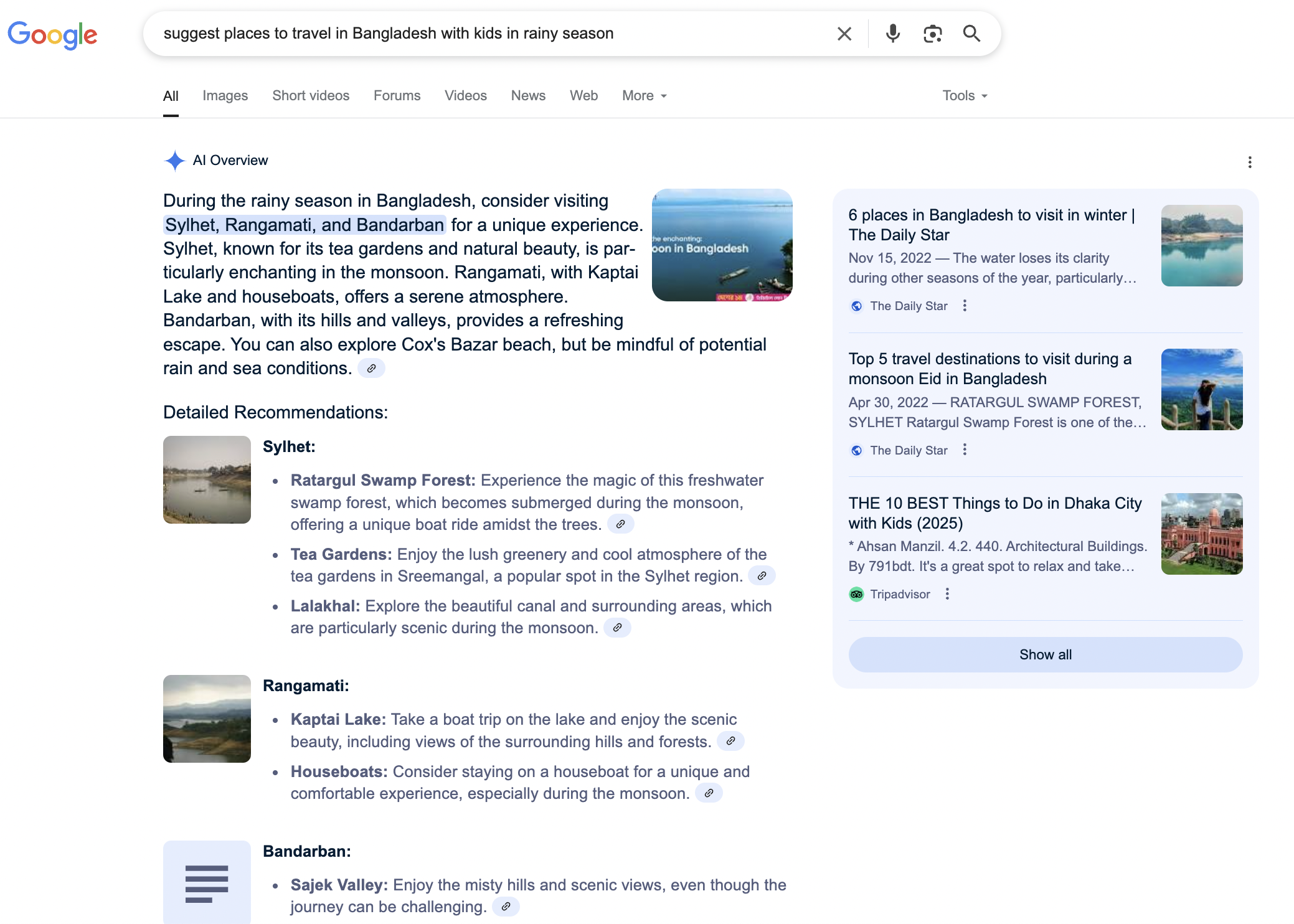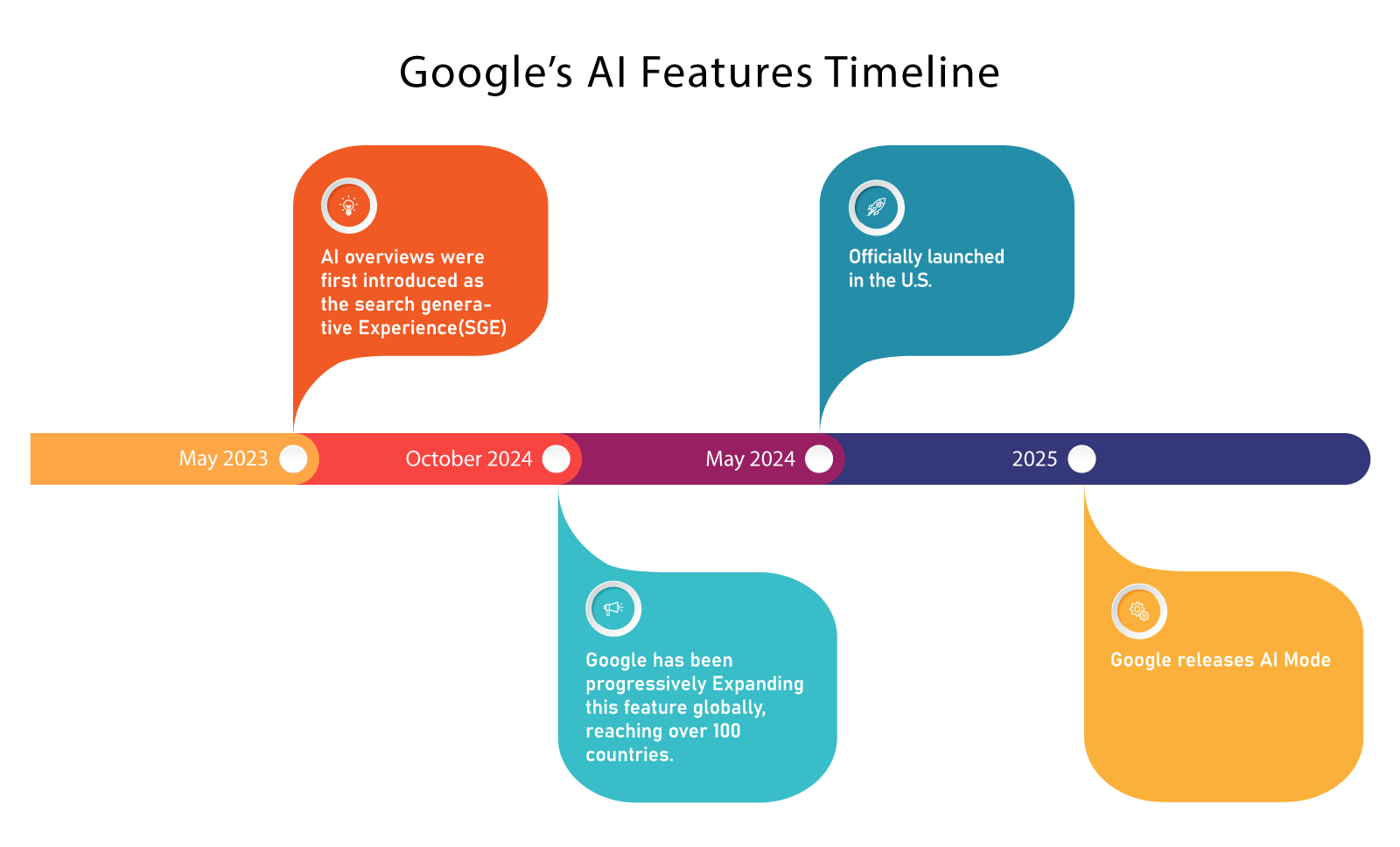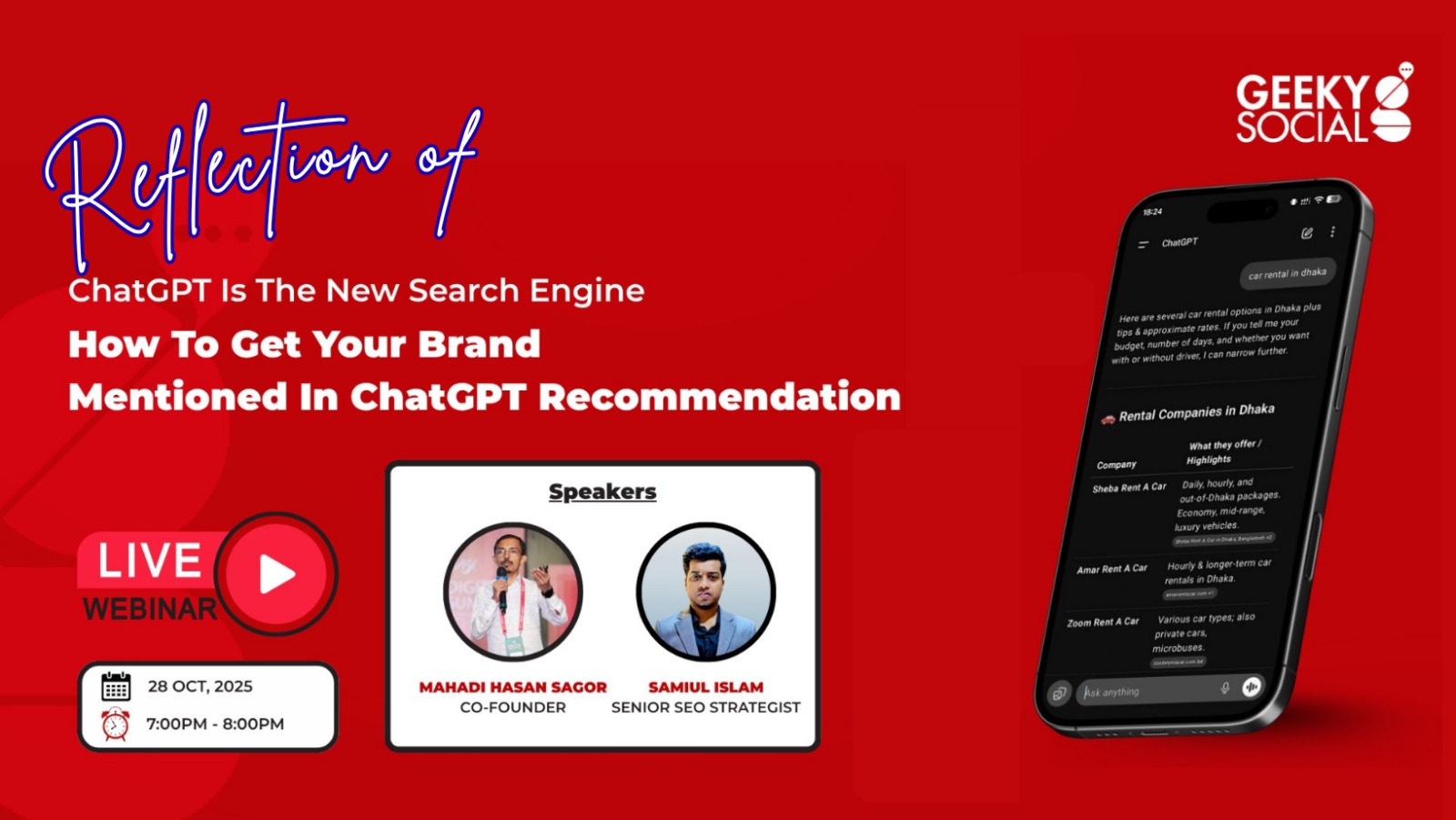
Google’s AI Revolution: How AI Overview and AI Mode Are Reshaping SEO in 2025
- Published on

Table of Contents
The way people search on Google has quietly undergone its biggest transformation since the search engine’s inception. Google’s AI Overview and the newly launched AI Mode are not just features, they’re reshaping how millions of users find information, products, and services online.
This deep dive will unravel the new reality of Google Search, explain how it differs from the past, shed light on its impact on your SEO outcomes, and, most importantly, equip you with the knowledge to react strategically and prepare your brand for tomorrow.
Understanding Google's AI Search Features
For years, when we search on Google, Google refers to a list of links. We click the links, browse, and find our answer; this is changing fundamentally with the integration of Artificial Intelligence.
In May 2024, Google introduced two new AI-powered features that are reshaping its core search experience:
1. AI Overviews (formerly SGE)
AI Overviews are Google’s way of summarizing answers directly within the search results. When users search for complex or multifaceted queries, such as “suggest places to travel in Bangladesh with kids in rainy season. “Google now delivers a multi-paragraph AI-generated answer right at the top of the page. This summary pulls from multiple websites, sources, and types of content to synthesize a comprehensive response.
Notably:
- Users often get the information they need without clicking a single link.
- Sources are cited, but not always prominently.
- The overview can evolve as users refine or extend their questions.

2. AI Mode (Experimental)
AI Mode is more interactive. It lets users have a back-and-forth conversation with Google’s search engine, powered by Gemini 2.5. Instead of a static list of links or even a single overview, users can ask follow-up questions, compare results, and explore topics through a chatbot-like interface.
This model borrows from tools like ChatGPT or Perplexity, but with Google’s indexing power and real-time web context.
This is currently being rolled out in the United States and is expected to be available globally soon.
3. Audio and Multimodal Search
Google is also experimenting with voice summaries, essentially auto-generated podcasts for search results and visual or image-based AI interactions. This shift hints at a future where search isn’t just text-based, but multi-sensory and responsive to individual learning styles.

What are the impacts of these new updates?
These features aim to provide users with faster, more comprehensive answers directly within the search results, reducing the need to click through to multiple websites. This fundamentally changes the user journey and, by extension, the game of SEO.
Historically, the primary goal of SEO was to ensure our website ranked high on Google’s search results page, ideally in the top 1-3 positions. The assumption was that higher rankings led to more clicks, and in turn, more clicks meant more traffic to the site.
With the advent of AI Overviews, we’re seeing a significant shift. Imagine one is searching for ” the best way to remove a coffee stain from carpet”. Instead of just seeing a list of articles, he/she might immediately get a concise, step-by-step answer in an AI Overview. While this is incredibly convenient for the user, it introduces the concept of “zero-click searches.”
What is “zero-click search”?
A zero-click search is exactly what it sounds like: a user finds their answer directly on the Google search results page without needing to click through to any website. If users are getting their answers instantly, even if your site is ranked highly and was used as a source for the AI Overview, they might not click on your link. This can lead to a decrease in click-through rates (CTR) for traditional organic listings.
Impact on Existing Rankings and Organic Traffic
The introduction of AI Overviews and the rise of AI Mode are already having a significant impact on organic traffic and traditional SEO metrics. Let’s dive deeper.
- Reduced Clicks: Studies are showing a clear trend: when an AI Overview appears in search results, the number of clicks to outside websites decreases. Some research suggests outbound clicks can fall by nearly two-thirds on desktop and almost half on mobile. This is because users are getting their answers directly from Google’s summary, eliminating the need to visit a website.
“A study by Ahrefs found that AI Overviews can reduce clicks by as much as 34.5%.”
2. Shift in User Behavior: Users are becoming accustomed to instant answers. A study by Search Engine Land revealed that most users only read about a third of Google’s AI Overviews and rarely click on the citations within them. Interestingly, when users leave AI Overviews, about one third often turn to community-based platforms like Reddit or YouTube for social proof and real-world experiences. This indicates a growing demand for authentic, human-generated content alongside AI summaries.
3. New “Trust Standard”: Google is positioning AI Overviews and AI Mode as highly trustworthy sources of information. This means that for your brand to be considered in these AI-generated answers, you need to be seen not just as an option, but as a cited authority. If your brand isn’t featured in these summaries, you risk being excluded from the user’s decision journey.
This new reality means that simply ranking on page one isn’t enough anymore. The focus is shifting to becoming the definitive source that Google’s AI turns to for information and recommendations.
How Do We Adapt Our SEO Strategy for AI Search?
The core idea is that SEO is no longer just about ranking for keywords. It’s increasingly about becoming a trusted source of comprehensive, helpful, and high-quality information that Google’s AI can confidently use and refer users to. Our expert SEO team identifies below strategies essential to rank in Ai Overview:
1. Prioritize the EEAT framework
Google has long emphasized EEAT (Experience, Expertise, Authoritativeness, and Trustworthiness) in evaluating content. With AI Overview, these principles are more critical than ever.
E – Experience: This refers to firsthand, real-world involvement with the topic.
E – Expertise: This highlights the deep, specialized knowledge and qualifications of the content creator.
A – Authoritativeness: This measures how recognized and influential the content creator or website is within their industry.
T – Trustworthiness: This focuses on the reliability, honesty, and transparency of the content and the source.
2. Structure content for AI consumption
- Use clear headings, bullet points, and concise answers that can be easily cited by AI models.
- Include FAQ sections to address common questions.
- Ensure schema markup is correctly implemented to help search engines interpret your content.
3. Strengthen branded visibility across channels
If users don’t click through, your brand still needs to make an impression:
- Ensure your brand name appears in cited sources.
- Increase engagement on platforms like YouTube and LinkedIn, which often feed into AI summaries.
- Build authority via thought leadership, webinars, and collaborations that can be referenced by AI systems.
AI Overview represents both a challenge and an opportunity. By focusing on creating credible, well-structured, and authoritative content, brand managers can ensure their brands stay visible even in a Zero-Click world.
It’s time to reimagine SEO as Search Experience Optimization, where success means not just ranking high, but becoming part of the answers users see first.
Monitoring and Measurement in the AI Era
The metrics for SEO success are shifting. While keyword rankings and organic traffic remain important, the AI era demands a more nuanced approach to measurement.
- Beyond Keyword Rankings: Individual keyword rankings might become less relevant as AI Overviews aim to answer queries directly. Instead, focus on:
- Topic Visibility: Are you being cited or featured in AI Overviews for broad topics related to your industry? Tools can help track when your brand or content appears in these summary boxes.
- Brand Mentions: Track how often your brand is mentioned across the web, especially in reputable publications and community forums. AI models consider brand mentions as a strong signal of authority and trustworthiness.
- Share of Voice in AI Overviews: Monitor how frequently your brand is sourced or referenced within AI Overviews for relevant queries. This is a direct indicator of your E-E-A-T in action.
2. Engagement Metrics over Clicks: Since direct clicks might decrease, focus on metrics that indicate user engagement and trust once they land on your site or interact with your content:
- Pages per Session: Are users exploring multiple pages on your site after an organic visit?
- Time on Page/Session Duration: Are users spending significant time consuming your content?
- Conversion Rates from Organic Visitors: Are organic visitors completing desired actions (e.g., making a purchase, filling out a form, downloading a brochure)?
- Bounce Rate: A high bounce rate might indicate that your content isn’t meeting user expectations even if they click through.
3. Attribution Modeling: It’s more important than ever to understand the entire customer journey, not just the last click. AI Overviews might be the first touchpoint, leading users to later search for your brand directly or through other channels. Invest in robust attribution models to understand the true impact of your SEO efforts across different touchpoints.
4. Qualitative Feedback: Don’t underestimate the power of direct user feedback. Conduct surveys, monitor social media conversations, and engage with your audience to understand their search habits and how they perceive AI-generated answers. This qualitative data can provide insights that quantitative metrics might miss.
The AI revolution in search is not a threat to SEO; it’s an evolution. Brands that embrace this change, prioritize authentic E-E-A-T, and adapt their measurement strategies will not only survive but thrive in this new digital era. At GEEKY Social, we are committed to helping your brand navigate these transformations and emerge as a knowledge leader in your market. Need help, contact us.
Key Takeaways for Brand Managers Like You
Let’s wrap this up with a clear, actionable checklist to help you thrive in Google’s AI-first search ecosystem:
Embrace AEO (Answer Engine Optimization)
- 1. Write content that directly answers common questions in your niche.
- 2. Use clear formatting—headings, bullets, TL;DRs.
Optimize for E-E-A-T
- 1. Show expertise and credentials.
- 2. Share real-world experience and results.
- 3. Be cited by other authoritative voices.
- 4. Be transparent, accessible, and accurate.
Invest in Structured Content
- 1. Use FAQ schema, How-To markup, and Author profiles
- 2. Format content for both AI readability and human scannability.
Monitor and Adapt
- 1. Don't just chase keywords—track questions and user intent.
- 2. Watch for AI citation trends and adjust accordingly.
Think Beyond the Click
- 1. Focus on brand presence and conversion outcomes.
- 2. Position your content to educate, not just rank.
Share Now on social media
Join Our Newsletter
Stay up-to-date with latest media insights and updates





